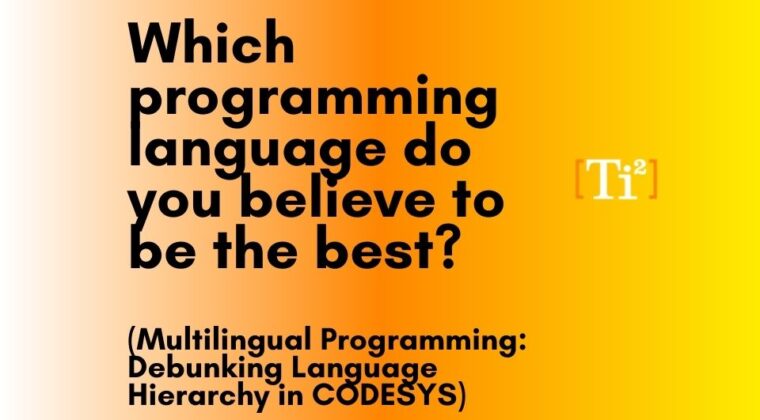
In the realm of industrial automation, the choice of programming language is often a topic of debate. One of our LinkedIn post reached a new height of debate while discussing CODESYS, which quite fairly was an enlightening discussion about the parallels between CODESYS and Android in the automation industry.
This leads to the next topic: While graphics-based languages like Sequential Function Charts (SFC), Ladder Diagrams (LD), and Continuous Function Charts (CFC) have their passionate advocates, text-based languages such as Structured Text (ST) also have their merits.
In this blog post, we will take a balanced approach to explore the strengths of both graphics-based and text-based languages in CODESYS. By debunking the notion of a language hierarchy, we aim to emphasise the importance of leveraging all limbs and choosing the right language for the right task.
1. Embracing Function-Specific Languages:
In addition to selecting the right programming language for the overall project, it is crucial to choose the right language for each specific function within the project. This approach maximises the strengths of each language and leads to more efficient and effective automation development. Let’s explore some examples:
– Relays and Timers: Ladder Diagrams (LD)
LD is widely used for relay-based control systems. Its graphical representation resembles traditional relay circuits, making it intuitive for programming relay and timer functions. LD’s visual nature allows developers to easily understand and troubleshoot the logic, simplifying maintenance and debugging processes.
– Sequences and State Machines: Sequential Function Charts (SFC)
SFC provides a visual representation of complex processes, making it ideal for modeling and programming sequential control systems. With SFC, developers can easily design and manage intricate state-based processes, ensuring smooth transitions and coordinated actions between different states.
– Iterations and Decisions: Structured Text (ST)
Structured Text (ST) is a text-based language that excels in handling complex calculations, iterations, and decision-making processes. With ST, developers can utilise variables, loops, and conditional statements to implement sophisticated algorithms and mathematical operations. ST empowers programmers with precise control and computational capabilities.
– Block Diagrams and Block-Based Design: Continuous Function Charts (CFC)
Continuous Function Charts (CFC) employ block diagrams to facilitate the design of complex control structures. CFC allows developers to visualise and represent the interconnections between different function blocks, making it easier to design, understand, and maintain complex control systems.
2. Limitations of Restricting Oneself to a Single Language:
Limiting oneself to only one programming language in CODESYS is akin to using only one arm or one leg. Each language has its strengths and areas of expertise, and by restricting oneself, developers miss out on the unique advantages that other languages offer. By embracing multilingual programming, developers can leverage the specific features and constructs of each language to optimise their automation projects.
3. The Importance of Learning and Applying All Languages:
To fully exploit the potential of CODESYS, it is recommended to learn and become proficient in all available languages. By expanding your skillset to encompass multiple languages, you gain the ability to choose the most appropriate language for each function within your automation projects. This approach enhances your versatility as a developer, enabling you to implement efficient and tailored solutions for different automation tasks.
Conclusion
In the world of CODESYS programming, limiting oneself to only one language is a missed opportunity. By embracing a multilingual approach, developers can choose the right language for each function within their automation projects, harnessing the strengths of each language. Relays and timers can be programmed using Ladder Diagrams (LD), sequences and state machines with Sequential Function Charts (SFC), iterations and decisions through Structured Text (ST), and block diagrams and block-based designs using Continuous Function Charts (CFC). Embracing this approach unlocks the full potential of CODESYS, leading to more efficient, adaptable, and robust automation systems. So, let’s break free from limitations, learn all the languages, and apply each where they are best suited, ensuring that we utilise every limb available to us in the world of industrial automation programming.
Want to learn more about CODESYS? The CODESYS Academy is an online platform that offers self-paced CODESYS courses and certifications. They provide in-depth training on different CODESYS topics, including programming, visualisation, motion control, and more. You can find their courses and additional resources at codesys.academy.
Contact us HERE to learn more about CODESYS and how it can help your industrial automation projects to unlock its benefits and drive innovation in your industry.
Or to learn more about what we can do to help your automation requirements, please click projects, products & services.
Ti2 is currently very focused on working with its global partners to secure stock and avoid long delay times in delivering products to their customers. Together with our trusted partners, we are here to provide solutions for your needs.
Please click here to email us your inquiry, we would like to hear from you.
